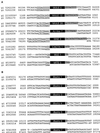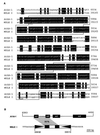Transposon diversity in Arabidopsis thaliana
- PMID: 10861007
- PMCID: PMC16553
- DOI: 10.1073/pnas.97.13.7376
Transposon diversity in Arabidopsis thaliana
Erratum in
- Proc Natl Acad Sci U S A 2001 Mar 27;98(7):4276
Abstract
Recent availability of extensive genome sequence information offers new opportunities to analyze genome organization, including transposon diversity and accumulation, at a level of resolution that was previously unattainable. In this report, we used sequence similarity search and analysis protocols to perform a fine-scale analysis of a large sample ( approximately 17.2 Mb) of the Arabidopsis thaliana (Columbia) genome for transposons. Consistent with previous studies, we report that the A. thaliana genome harbors diverse representatives of most known superfamilies of transposons. However, our survey reveals a higher density of transposons of which over one-fourth could be classified into a single novel transposon family designated as Basho, which appears unrelated to any previously known superfamily. We have also identified putative transposase-coding ORFs for miniature inverted-repeat transposable elements (MITEs), providing clues into the mechanism of mobility and origins of the most abundant transposons associated with plant genes. In addition, we provide evidence that most mined transposons have a clear distribution preference for A + T-rich sequences and show that structural variation for many mined transposons is partly due to interelement recombination. Taken together, these findings further underscore the complexity of transposons within the compact genome of A. thaliana.
Figures






References
-
- Berg D E, Howe M M, editors. Mobile DNA. Washington, DC: American Society for Microbiology; 1989.
-
- McDonald J F. Trends Ecol Evol. 1995;10:123–126. - PubMed
Publication types
MeSH terms
Substances
LinkOut - more resources
Full Text Sources
Other Literature Sources
Miscellaneous

